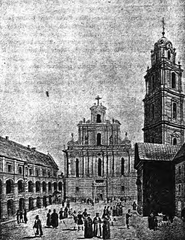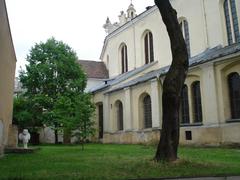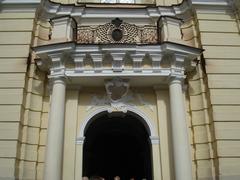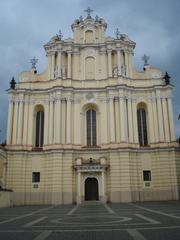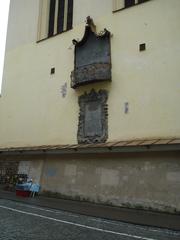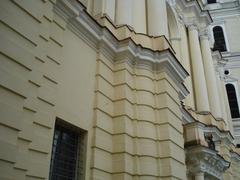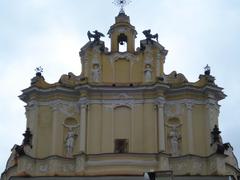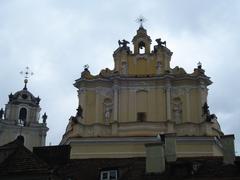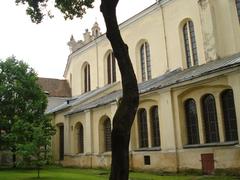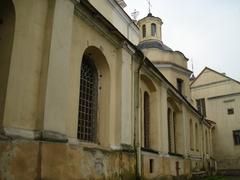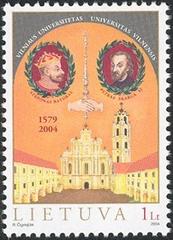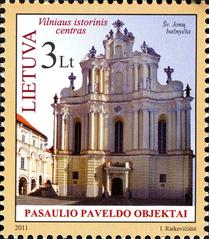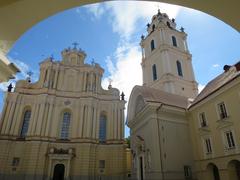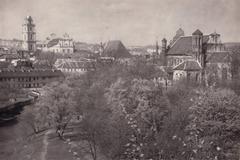
Church of St. Johns Vilnius: Visiting Hours, Tickets, and Historical Significance
Date: 14/06/2025
Introduction
Nestled within the heart of Vilnius Old Town and integrated into the Vilnius University ensemble, the Church of St. Johns (Šv. Jonų bažnyčia) stands as a remarkable emblem of Lithuania’s religious, academic, and architectural heritage. Founded in the late 14th century soon after Lithuania’s Christianization, the church has evolved through a blend of Gothic, Renaissance, Baroque, and Classical styles. Today, it not only serves as a center of Catholic worship but also as a venue for academic ceremonies, cultural events, and musical performances, all while remaining a key destination for visitors seeking to experience the depth of Vilnius’s historical and cultural landscape. The adjacent 68-meter bell tower offers panoramic views of the UNESCO-listed Old Town, making the site a favorite for both locals and tourists.
This comprehensive guide covers everything you need to know before visiting the Church of St. Johns: its historical background, architectural highlights, visiting hours, ticketing details, accessibility, nearby attractions, and practical tips for making the most of your visit. For further information, consult official resources and tourism portals. (ldkistorija.lt, govilnius.lt, VU Museum)
Table of Contents
- Historical Overview
- Architectural Features
- Cultural and Academic Significance
- Visiting Information
- Nearby Attractions
- Visitor Tips
- Frequently Asked Questions (FAQ)
- Conclusion
- References
Historical Overview
Foundations and Medieval Origins:
Construction of the Church of St. Johns began in 1386, following Lithuania’s Christianization under King Władysław II Jagiełło. Over the next four decades, the church was built to serve Vilnius’s expanding Catholic community as the city became a major political and religious center. (ldkistorija.lt)
Jesuit and University Influence:
In 1571, the Jesuits assumed stewardship, aligning the church with the newly established Vilnius University in 1579. The church soon became a focal point for academic, spiritual, and cultural life, hosting university ceremonies and public debates. (lrt.lt)
Baroque Transformation:
The 17th and 18th centuries saw the church’s transformation after major fires, when architect Johann Christoph Glaubitz led a Baroque reconstruction. The result is a harmonious blend of Gothic foundations and Baroque grandeur, evident in both the church and the bell tower. (ldkistorija.lt)
Enduring Symbol:
Despite fires, wars, and Soviet-era repurposing, the Church of St. Johns has remained a symbol of Vilnius’s resilience and cultural continuity. It was reconsecrated in 1991 and continues to play a major role in the city’s academic, religious, and social life. (govilnius.lt)
Architectural Features
Exterior
The church’s exterior reflects its architectural evolution. Initially built in Gothic style with pointed arches and ribbed vaults, it was later enhanced with Baroque elements—curved facades, elaborate stucco, and an ornate pediment—after the 18th-century reconstruction. The church is seamlessly integrated into the Vilnius University architectural ensemble, surrounded by historic courtyards and academic buildings. (VU Museum)
The Bell Tower:
Standing at 68 meters, the bell tower is the tallest structure in Vilnius Old Town. Built in the early 17th century and reconstructed after the 1737 fire, it combines Renaissance and Baroque features, with arched windows, original bells, and a distinctive spire. Visitors can ascend the tower via stairs or a modern elevator to enjoy panoramic city views. (Go Vilnius)
Interior
The church preserves its medieval Gothic spatial design, with a vaulted nave and ribbed arches. Baroque ornamentation, including gilded moldings, stucco floral motifs, and religious iconography, adds dramatic effect throughout the interior. The grand altar—one of Lithuania’s largest—displays soaring columns, gilded statues, and an elaborate canopy. (VU Museum)
The Organ:
The church is home to Lithuania’s largest organ, Unda Maris, originally brought from Polotsk. Its restoration and use since 2000 have made it a centerpiece of concerts and university celebrations. (vu.lt)
Bell Tower Experience
The observation deck, reached by 193 wooden steps or elevator, provides 360-degree panoramic views of Vilnius. On the second floor, a rare Foucault Pendulum demonstrates Earth’s rotation, blending scientific interest with historical context. (VU Museum)
Cultural and Academic Significance
The Church of St. Johns is inseparable from the life of Vilnius University, serving as a venue for graduations, academic ceremonies, and scholarly debates since the 16th century. The church also hosts concerts (such as “Alma Mater Musicalis”) and cultural events, leveraging its excellent acoustics and historic ambiance. It remains a spiritual home for the university community, with regular services, prayer groups, and the Chapel of priest Alfonsas Lipniūnas providing pastoral care. (vu.lt, cityofmercy.lt)
During the Soviet era, the church was repurposed but remained a symbol of continuity. Its return to active religious and academic use in 1991 marked a new chapter in its storied history. Recognition for its cultural value includes the European Gold Medal for monument protection and representation in Brussels’ Mini-Europe Park. (vu.lt)
Visiting Information
Hours and Tickets
Church Visiting Hours:
- Monday–Saturday: 9:00–18:00
- Sunday: 10:00–14:00 (September–May), 10:00–12:00 (June–August)
(Vilnius Archdiocese)
Bell Tower Hours:
- Open from April to October, daily 10:00–19:00 (last entry 18:30)
- Entrance: 12 St John’s Street
- Tickets: Individual tickets available on-site; guided tour for groups up to 25 persons: €10 (registration required for groups)
(Vilnius University Museum)
Admission:
- Entry to the church is free; donations are appreciated.
- Bell tower access requires a ticket (current rates: adults €3–5, students/pensioners €2–3, children under 7 free; check the official site for up-to-date prices).
Accessibility
- The church and university courtyards are accessible for visitors with limited mobility.
- The bell tower has an elevator, making the observation deck accessible, though the final climb may require use of stairs.
Guided Tours and Mass Schedule
- Guided tours are available in multiple languages; advance booking recommended.
- Mass is held regularly—see the official schedule for current times.
(Generally: Sunday 11:00, 13:00, 19:00; Tuesday–Thursday 18:00; Wednesday 12:00).
Contact:
- Vilnius University Museum: +370 5219 3029
- Bell Tower: +370 6168 3269
- Email: [email protected]
Nearby Attractions
- Vilnius University: Explore historic courtyards and the university library.
- Presidential Palace: A short walk away.
- Vilnius Old Town: UNESCO World Heritage area with shops, cafés, and landmarks like Gediminas Tower and Town Hall Square.
- Vilnius University Botanical Garden.
Visitor Tips
- Visit early or late in the day for a quieter experience and better photography lighting.
- Dress modestly (cover shoulders and knees), especially if attending Mass.
- Photography is permitted; avoid flash and tripods during services.
- Wear comfortable shoes for the bell tower climb.
- Restrooms and souvenir stands are available within the university complex.
- Combine your visit with other nearby historical sites for a fuller experience.
Frequently Asked Questions (FAQ)
Q: What are the Church of St. Johns visiting hours?
A: Monday–Saturday, 9:00–18:00; Sunday, 10:00–14:00 (seasonal variations apply).
Q: Do I need tickets to visit the church?
A: No, church entry is free; only the bell tower requires a ticket.
Q: Is the bell tower accessible for visitors with disabilities?
A: The tower has an elevator, but the final ascent may involve stairs.
Q: Are guided tours available?
A: Yes, book through the Vilnius University Museum in advance.
Q: Can I attend Mass?
A: Yes; see the official schedule for times.
Q: What are some nearby attractions?
A: Vilnius University, Presidential Palace, Old Town landmarks, Gediminas Tower.
Conclusion
The Church of St. Johns in Vilnius embodies the city’s religious, academic, and cultural evolution. Its stunning architecture, storied history, and vibrant role in university and community life make it a highlight for any visitor. Whether you’re drawn by its Gothic nave, Baroque ornamentation, panoramic bell tower views, or musical heritage, your visit promises both inspiration and insight into Vilnius’s enduring spirit.
For the latest updates on events, visiting hours, or guided tours, consult the Vilnius University Museum website and consider downloading the Audiala app for audio guides and real-time news. Discover more of Vilnius’s historical sites and enrich your journey through Lithuania’s capital.
References
- Church of St. Johns Vilnius: Visiting Hours, Tickets, and Historical Guide, 2025, ldkistorija.lt
- Visiting the Church of St. Johns in Vilnius: Hours, Tickets, and Historical Insights, 2025, VU Museum & Go Vilnius
- Cultural and Academic Significance, 2025, Vilnius University & govilnius.lt, govilnius.lt
- Church of St. Johns Vilnius: Visiting Hours, Tickets & Travel Tips, 2025, Vilnius University Museum & Vilnius Archdiocese, Vilnius Archdiocese
